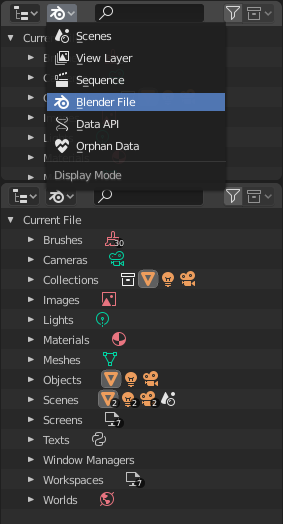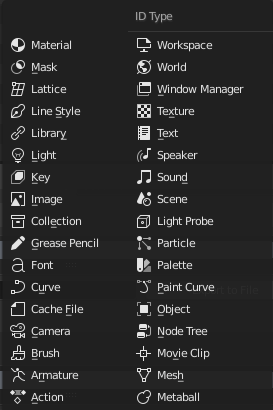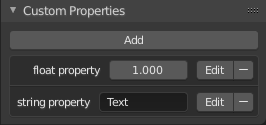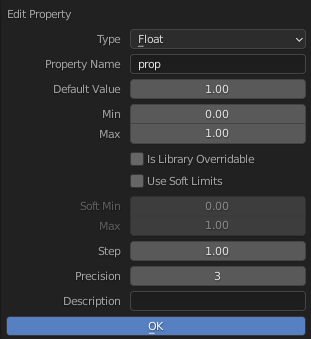Блоки данных
Базовой единицей (unit) любого проекта Blender является блок данных. Примеры блоков данных включают в себя: меши, объекты, материалы, текстуры, древа нод, сцены, тексты, кисти и даже рабочие области.

Представление файла Blender в аутлайнере.
Блок данных – это общая абстракция самых разных типов данных, которая имеет общий набор основных функций, свойств и поведения.
Некоторые общие характеристики:
Они являются основным содержимым blend-файла.
Они могут ссылаться друг на друга для повторного использования и создания экземпляров. (Дочерний/родительский объект, данные объекта/объект, материалы/изображения, в модификаторах или также в ограничениях…)
Их имена уникальны в пределах blend-файла для данного типа.
Их можно добавлять/удалять/редактировать/дублировать.
Их можно связать между файлами (включено только для ограниченного набора блоков данных).
Они могут иметь свои собственные данные анимации.
They can have Custom Properties.
Пользователь обычно взаимодействует с типами данных более высокого уровня (объектами, мешами и т. д.). При выполнении более сложных проектов управление блоками данных становится более важным, особенно при связывании blend-файлов. Основным редактором для этого является аутлайнер.
Не все данные в Blender представляют собой блоки данных. Кости, дорожки секвенций или группы вершин, к примеру, принадлежат к типам арматуры, сцены и меша соответственно.
Типы блоков данных

Типы блоков данных с их значком.
Для справки, вот таблица типов блоков данных, хранящихся в blend-файлах.
- Связать (Link)
Связывание библиотек, поддерживает связывание с другими blend-файлами.
- Упаковать (pack)
Упаковка файлов: поддерживает упаковку содержимого файла в blend-файл (неприменимо для большинства блоков данных, которые не имеют ссылки на файл).
Тип (type) |
Связать (Link) |
Упаковать (pack) |
Описание |
|---|---|---|---|
✓ |
— |
Stores animation F-Curves.
Used as data-block animation data,
and the Nonlinear Animation editor.
|
|
✓ |
— |
Skeleton used to deform meshes.
Used as data of armature objects, and by the Armature Modifier.
|
|
✓ |
— |
Used by paint tools.
|
|
✓ |
— |
Используется в качестве данных объектами-камерами.
|
|
✓ |
— |
Используется модификаторами кэша меша (mesh cache).
|
|
✓ |
— |
Используется в качестве данных объектами кривой, шрифта и поверхности.
|
|
✓ |
✓ |
References font files.
Used by curve object-data of text objects.
|
|
✓ |
— |
2D/3D sketch data used by Grease Pencil objects.
Used as overlay helper info, by the
3D Viewport, Image, Sequencer & Movie Clip editors.
|
|
✓ |
— |
Group and organize objects in scenes.
Used to instance objects, and in library linking.
|
|
✓ |
✓ |
Image files.
Used by shader nodes and textures.
|
|
✗ |
— |
Geometry shape storage, which can be animated.
Used by mesh, curve, and lattice objects.
|
|
✓ |
— |
Используется в качестве данных объекта объектами освещения.
|
|
✗ |
✓ |
References to an external blend-file.
Access from the Outliner’s Blender File view.
|
|
✓ |
— |
Используется рендерером Freestyle.
|
|
✓ |
— |
Grid based lattice deformation.
Used as data of lattice objects, and by the Lattice Modifier.
|
|
✓ |
— |
2D animated mask curves.
Used by compositing nodes & sequencer strip.
|
|
✓ |
— |
Set shading and texturing render properties.
Used by objects, meshes & curves.
|
|
✓ |
— |
An isosurface in 3D space.
Used as data of metaball objects.
|
|
✓ |
— |
Geometry made of vertices/edges/faces.
Used as data of mesh objects.
|
|
✓ |
✗ |
Reference to an image sequence or video file.
Used in the Movie Clip editor.
|
|
✓ |
— |
Groups of re-usable nodes.
Used in the node editors.
|
|
✓ |
— |
An entity in the scene with location,
scale, rotation.
Used by scenes & collections.
|
|
✓ |
— |
Stores a paint or sculpt stroke.
Access from the paint tools.
|
|
✓ |
— |
Store color presets.
Access from the paint tools.
|
|
✓ |
— |
Particle settings.
Used by particle systems.
|
|
✓ |
— |
Help achieve complex real-time lighting in Eevee.
|
|
✓ |
— |
Primary store of all data displayed and animated.
Used as top-level storage for objects & animation.
|
|
✓ |
✓ |
Reference to sound files.
Used as data of speaker objects.
|
|
✓ |
— |
Sound sources for a 3D scene.
Used as data of speaker object.
|
|
✓ |
✗ |
Text data.
Used by Python scripts and OSL shaders.
|
|
✓ |
— |
2D/3D textures.
Used by brushes and modifiers.
|
|
✗ |
— |
The overarching manager for all of Blender’s user interface.
Includes Workspaces, notification system, operators, and keymaps.
|
|
✓ |
— |
Определяет глобальные настройки среды рендера.
|
|
✗ |
— |
UI layout.
Used by each window, which has its own workspace.
|
Время существования
Для каждого блока данных подсчитывается использование (счётчик ссылок). Если их несколько, вы можете увидеть количество текущих пользователей блока данных справа от его имени в интерфейсе. Blender следует общему правилу, согласно которому неиспользуемые данные в конечном итоге удаляются.
Поскольку во время работы часто добавляется и удаляется большое количество данных, это имеет то преимущество, что не нужно вручную управлять каждым отдельным блоком данных. Это работает за счёт пропуска блоков данных с нулевыми пользователями при записи blend-файлов.
Защищено
Поскольку блоки данных с нулевыми пользователями не сохраняются, и бывают случаи, когда вы хотите принудительно сохранить данные независимо от их пользователей.
Если вы создаёте blend-файл, который будет служить библиотекой ассетов, к которому вы собираетесь ссылаться из других файлов, – вам необходимо убедиться, что они не будут случайно удалены из файла библиотеки.
Чтобы защитить блок данных, используйте кнопку со значком щита рядом с его названием. Блок данных никогда не будет автоматически удалён Blender’ом, но при необходимости вы всё равно сможете удалить его вручную.
Создание одного пользователя
Когда блок данных используется несколькими пользователями, вы можете сделать его копию для данного пользователя. Для этого нажмите кнопку подсчета пользователей справа от его имени. Это приведёт к дублированию этого блока данных и назначению вновь созданной копии только для этого использования.
Примечание
Объекты имеют набор более сложных действий, позволяющих стать однопользовательскими, см. их документацию.
Удаление блоков данных
Как описано в разделе «Время существования», блоки данных обычно удаляются, когда они больше не используются. Их также можно отсоединить или удалить вручную.
Отсоединение (unlinking) блока данных означает, что его пользователь больше не будет его использовать. Это можно сделать, щёлкнув значок «X» рядом с именем блока данных. Если вы отсоедините блок данных от всех его пользователей, он, в конечном итоге, будет удалён Blender’ом, как описано выше (если только он не является защищённым).
Удаление блока данных напрямую удаляет его из blend-файла, автоматически отделяя его от всех пользователей. Этого можно добиться, нажав Shift-ЛКМ на значке «X» рядом с его именем.
Предупреждение
Удаление некоторых блоков данных может привести к удалению некоторых его пользователей, которые без них станут недействительными. Основным примером является то, что удаление данных объекта (например меша, кривой, камеры…) также приведёт к удалению всех объектов, использующих их.
Эти две операции также доступны в контекстном меню при нажатии ПКМ на блок данных в аутлайнере.
Пользовательские свойства

Custom Properties panel.
Custom properties are a way to store your own data in Blender’s data-blocks. It can be used for rigging (where bones and objects can have custom properties driving other properties), and Python scripts, where it’s common to define new settings not available in Blender. It is also possible to access custom properties from materials via the Attribute Node.
Only certain data supports custom properties:
All data-blocks types.
Bones and pose bones.
Sequence strips.
To add a custom property, search for the Custom Properties panel, found at the bottom of most Properties or Sidebar region, and click New. Properties can be removed from the same location with the delete icon. Once properties are added they can be configured via the edit icon to work for a particular use case; see Editing Properties for more information.
Редактирование свойств
Интерфейс пользователя

Custom Properties edit pop-up.
Custom properties can be edited using the panel available for data types that support it. Editing the properties allows you to configure things such as default values, ranges, and even add a custom tooltip.
- Тип (type)
The data type of the property; different data types have can only have specific data properties.
- Нецелое (float)
A numeric value with decimals e.g. 3.141, 5.0, or 6.125.
- Float Array
A collection of multiple float data types e.g.
[3.141, 5.0, 6.125]. This data type can also be used for data that can be represented as a float array such as colors. These special float arrays can be set in the Subtype selector.- Целое число (integer)
A numeric value without any decimals e.g. 1, 2, 3, or 4.
- Integer Array
A collection of multiple integer data types e.g.
[1, 2, 3, 4].- Строка (string)
A sequence of characters such as «Some Text».
- Python
Edit a Python data type directly, used for unsupported data types.
Примечание
Boolean values must be handled as integers and only work when using Min/Max values that are integers and that are no more than 1 apart.
At this point, the Boolean values will still look like integers but behave like a Boolean having one lower, off, value and a higher, on, value.
- Array Length
The number of elements in the array. Note that if the array length is greater than 7 you cannot directly edit its elements, you must press Edit Value to edit the elements of the array.
- Имя свойства
The text that is displayed to the left of the value. This name is also used to access the property via Python.
- Значение по умолчанию
This sets the default value of the property used by the Reset to Default Value operator.
Предупреждение
Default values are used as the basis of NLA blending, and a nonsensical default (e.g. 0 for a property used for scaling) on a property intended for being keyframed is likely to cause issues.
- Мин, Макс (min, max)
The minimum/maximum value the custom property can take.
- Переопределяемая библиотека
Allow the property to be overridden when the data-block is linked.
- Плавные ограничения
Enables limits that the Property Value slider can be adjusted to without having to input the value numerically.
- Soft Min, Max
The minimum/maximum value for the soft limit.
- Step
A multiplier to control how much the data type is incremented at a time. The internal step size for floats is 0.01, so a Step value of 5 will increment at a rate of 0.05 and a Step value of 100 will increment by 1.0. For integers the internal step size is 1.
- Точность (precision)
The number of digits after the decimal to display in the user interface for float data types.
- Subtype
Specifies the type of data the property contains, which affects how it appears in the user interface. In order for this property to appear the Property Value must be a vector of floats. For either of the color subtypes to work the Property Value must be a vector with three or four values depending on the availability of an Alpha Channel.
- Plane Data
Data values do not have any special behavior.
- Линейный цвет
Color in linear color space.
- Gamma-Corrected Color
Color in gamma corrected color space.
- Углы Эйлера (Euler Angles)
:term:Углы Вращения Эйлера.
- Кватернионные углы
:term:Углы Вращения кватерниона.
- Описание
Allows you to write a custom Tooltip for your property.
Доступ Python
Custom properties can be accessed in a similar way to dictionaries, with the constraints that keys can only be strings, and values can only be strings, numbers, arrays of such, or nested properties.
See the API documentation for details.